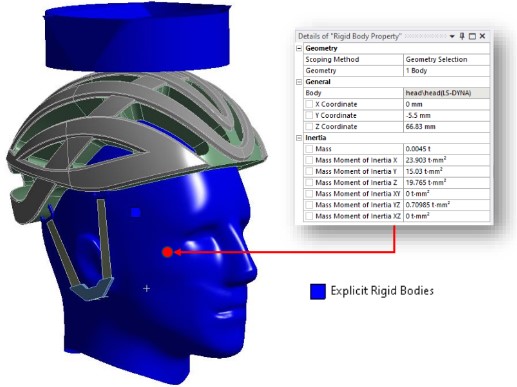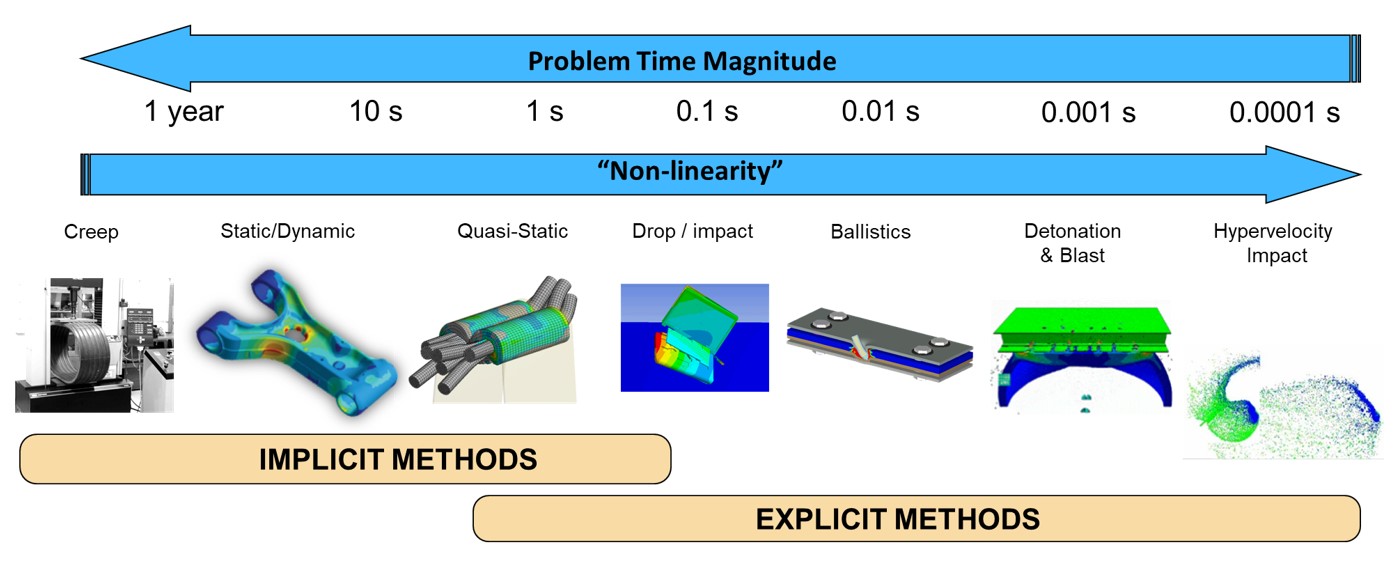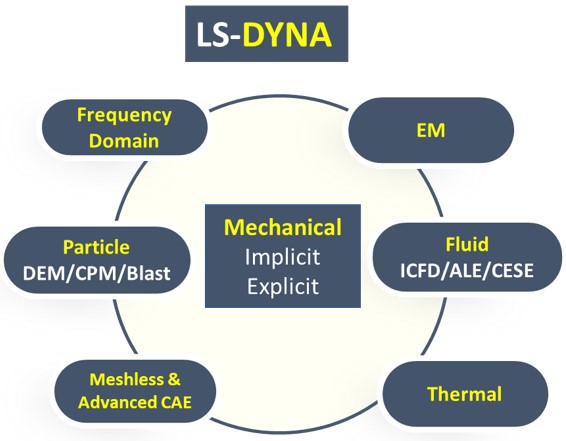Ansys LS-DYNA is the industry-leading explicit simulation program for drop checks, impact and penetration, smashes and collisions, occupant protection, and other applications.
Ansys LS-DYNA explicit simulation software is the most widely used in the world, and it can simulate the response of materials to short periods of extreme loading.
Its numerous components, touch formulas, material models, and other controls can be used to simulate complex models while maintaining complete control over all of the problem’s specifics.


Engineers can look at material failure simulations to see how the failure progresses through a component or a device.


Ansys LS-DYNA Key Features
The ICFD solver is a standalone CFD code with a steady-state solver, transient solver, RANS/LES turbulence model, free surface flows, and isotropic/anisotropic porous media flow. Structural, EM, and thermal solvers are all related.
Multiphysics Solver include ICFD for Incompressible Fluids, electromagnetic solver, EM for battery abuse, and CESE for compressible fluids.
Easily switch between Implicit and Explicit solvers for your different runs.
In the Eddy current approximation, EM solves the Maxwell equations using FEM and BEM. This is appropriate in situations where electromagnetic wave propagation in air (or vacuum) may be considered instantaneous. Magnetic metal formation or welding, induced heating, and battery abuse simulation are the main applications.
Ansys LS-Dyna supports a variety of particle approaches. AIRBAG PARTICLE is a class that represents airbag gas particles as a group of rigid particles moving randomly. PARTICLE BLAST is a high-explosive particle gas model that simulates high-explosive gas and air. Discrete element method includes applications such as agriculture and food handling, chemical and civil Engineering, mining, and mineral processing.
Users of Ansys LS-Dyna can use frequency domain analysis to investigate features like frequency response function, steady state dynamics, random vibration, response spectrum analysis, acoustics BEM and FEM, and fatigue SSD and random vibration. These capabilities can be used in NVH, acoustic analysis, defense industry, fatigue analysis, and earthquake engineering, among other applications.
In Ansys LS-DYNA, a contact is specified by specifying the locations should be tested for possible slave node penetration through a master segment (via sections, part sets, segment sets, and/or node sets). Every time, a search for penetrations is conducted using one of several different algorithms. When a penetration is discovered in a penalty-based touch, a force proportional to the penetration depth is applied to resist and eventually remove the penetration. Rigid bodies should be used in any penalty-based touch, but in order for the contact force to be distributed realistically, the mesh defining any rigid body should be as fine as that defining a deformable body.
Several tools for local volume mesh refining are offered in order to better capture mesh sensitive phenomena like turbulent eddies or boundary layer separation reattachment. The user may identify surfaces that will be used by the mesher to determine a local mesh size within the volume during the geometry setup. If no internal mesh is used to specify the size, the mesher will use a linear interpolation of the surface sizes that define the volume enclosure.
The SPH approach in Ansys LS-DYNA is combined with finite and discrete element approaches, allowing it to solve a wide range of complex problems including multiphysics explosion or fluid-structure interactions.
Mesh-free particle solvers in Ansys LS-DYNA are divided into two categories: continuum-based smooth particle hydrodynamics (SPH) and discrete particle solvers that use the discrete element method (DEM), particle blast method (PBM), and corpuscular particle method (CPM). Hypervelocity collisions, explosions, friction stir welding, water wading, fracture analysis in car windshields, window glass, and composite materials, metal friction drilling, metal machining, and high-velocity effects on concrete and metal targets are only a few of the uses for these solvers.
LS-OPT
Ansys LS-OPT is a stand-alone design optimization and probabilistic analysis kit with Ansys LS-DYNA integration. Project goals are always at odds, making it impossible to achieve an ideal design. For design optimization, LS-OPT employs a systematic approach involving an inverse process: First you specify the criteria and then you compute the best design according to a mathematical framework.
When a design is exposed to structural and environmental input variations that trigger a variance in response that could lead to undesirable behavior or failure, probabilistic analysis is required. Using several simulations, a probabilistic analysis assesses the impact of input variation on response variation and calculates the likelihood of failure.
Together, design optimization and probabilistic analysis help you to reach an optimal product design quickly and easily, saving time and money in the process.
Typical applications of LS-OPT include:
LS-TaSC
LS-TaSC™ is a Topology and Shape Computation tool. Developed for engineering analysts who need to optimize structures, LS-TaSC works with both the implicit and explicit solvers of Ansys LS-DYNA. LS-TaSC handles topology optimization of large nonlinear problems, involving dynamic loads and contact conditions.
Peridynamics & SPG
The smoothed particle Galerkin (SPG) method is a modern Lagrangian particle method for simulating ductile material failure’s extreme plastic deformation and material rupture. Another interesting approach for brittle fracture analysis in isotropic materials and composites like CFRP is the Peridynamics method. Modeling 3D material failure using a bond-based failure mechanism is a common feature of these two numerical methods. Since the material erosion technique is no longer needed, simulation of material failure processes becomes much more efficient and stable.
Isogeometric Analysis (IGA)
For numerical analysis, the isogeometric paradigm uses basis functions from computer-aided design (CAD). In comparison to finite element analysis (FEA), where the geometry is approximated with, theoretically higher-order, polynomials, the real geometry of the CAD parts is retained. Isogeometric analysis (IGA) has been extensively studied in recent years in order to (1) minimize the effort required to switch between design and analysis representations and (2) achieve higher-order accuracy through the use of higher-order interelement consistency in CAD. The implementation of generalized elements and then keywords supporting non-uniform rational B-splines in Ansys LS-DYNA is the first commercial code to support IGA (NURBS). Many common FEA features, such as touch, spot-weld models, anisotropic constitutive rules, and frequency domain analysis, are readily available in LS-DYNA, with new features being added on a regular basis.
Dummies
ATDs, also known as “crash test dummies,” are life-size mannequins with sensors that measure forces, moments, displacements, and accelerations. These data can then be used to predict the severity of injuries that a human will suffer during an impact. ATDs can, in theory, behave like real human beings while still being able to produce consistent results through multiple impacts. ATDs come in a wide range of sizes and shapes to represent different human sizes and shapes.
Barriers
LSTC offers several Offset Deformable Barrier (ODB) and Movable Deformable Barrier (MDB) models. LSTC ODB and MDB models are developed to correlate to several tests provided by our customers. These tests are proprietary data and are not currently available to the public.
Tires
LST jointly developed tire models with FCA. These models can be downloaded through the LST, Models download section. The models are based on a series of material, verification, and component level tests. The finite element mesh is based on 2D CAD data of the tire section. All major components of the tire use 8-noded hexahedron elements. The elastomers are modeled using *MAT_SIMPLIFIED_RUBBER and the plies are modeled using *MAT_ORTHOTROPIC_ELASTIC.